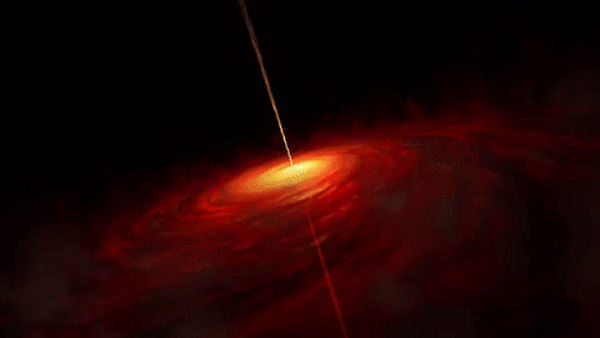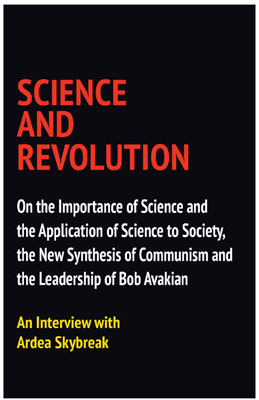Science, Humanity, and Seeing the “Unseeable”
| revcom.us
Wednesday, April 10, astronomers at six different sites around the globe announced the release of an image of a black hole, along with scientific papers backing up this very exciting scientific breakthrough and explaining it further.
Black holes have been one of the ultimate scientific expressions of what is real but cannot be seen by human eyes. A little more than 100 years ago, Albert Einstein completed the theories of special and general relativity. These are some of the fundamental theories in physics, and reveal a mind-bending universe in which time and space and matter (the stuff that makes up everything in the universe, from energy to atoms) are not separate things, as scientists had thought and everyday experience seems to show, but instead are interwoven, and they bend and twist and mix with and shape each other. Traveling clocks slow down with accelerating speed, and light bends as it travels around stars. Before scientists actually found evidence of black holes in the universe, general relativity pointed to their existence—matter squeezed so tightly, making the pull of gravity and the warping of time and space so great that nothing, not even light, can escape their grip.
The image of the black hole released this week is a further confirmation of Einstein’s theory. And it points to and opens the door to further exploration and deeper understanding of very basic things about our universe. All of this is a very big deal.
Bob Avakian (BA) has emphasized that “everything that is actually true is good for the proletariat, all truths can help us get to communism.” For more on this, we highly recommend “Bob Avakian in a Discussion with Comrades on Epistemology—On Knowing and Changing the World.” In this excerpt, BA talks about scientific discoveries like the Big Bang and what preceded it as both interesting in their own right and how they are, “not in a narrow way,” part of the rich process of the search for truth and the advance to communism. And everyone can learn science!*
We are including on this page a correspondence from a reader about this important scientific advance, as well as pictures and a video.
* See excerpt from the book SCIENCE AND REVOLUTION, On the Importance of Science and the Application of Science to Society, the New Synthesis of Communism, and the Leadership of Bob Avakian, An Interview with Ardea Skybreak, in which Skybreak makes the point, “I firmly believe–and I can provide evidence of this–that people who are not even trained in basic literacy can actually function as scientists.”

The just-released image of a black hole in the center of the galaxy Messier 87.
Why is the first-ever image of a black hole that was just made public by scientists a big deal?
Black holes are at the extreme limits of what science at this time can investigate and understand. They are so dense and their gravity is so powerful that nothing, including even light, can escape their grip. So until now, there has been no picture of what they are like. Now, scientists have found a way to get an image—so we can “see” what it is like around a black hole for the first time. This in itself is a big deal. More, this image confirms some of what scientists already knew—in particular, it confirms predictions of Albert Einstein’s general theory of relativity. And the successful observation of a black hole also opens up a new avenue to find out more about big, unanswered questions about the universe and matter. All of this is extremely important for humanity. The quest for knowledge continues.
Event Horizon Telescope “Sees” Black Hole for the First Time
From a reader:
This week, in an important scientific breakthrough, scientists released an image of a black hole in the center of the galaxy Messier 87, which is 55 million light-years away from the Earth. (A light-year, how far light travels in a year, is about 5,880,000,000,000 miles—so Messier 87 is very far away from Earth.1) The black hole is enormous—its mass is billions of times the mass of our sun.
“We have seen what we thought was unseeable,” said Shep Doeleman, the astronomer who headed up the globally coordinated effort to study black holes, which involved radio telescopes on four continents and is called the Event Horizon Telescope. The image that emerged is not a picture in the sense we usually think of these things. The telescopes were radio telescopes, which “see” and record radio waves, not light. A very big part of the scientific challenge in this was how to correctly coordinate, gather, and then compile information gathered from the corners of the Earth.2
But first, before going into that, a bit of background on black holes. Even the idea of black holes was originally startling to scientists. At first black holes were just a kind of theoretical abstraction—about 100 years ago, one scientist studying Albert Einstein’s theory of general relativity showed that the math in the equations Einstein developed pointed to how, if matter were packed densely enough, gravity would be so strong that nothing including light could ever escape.
Einstein himself at first found this so contrary to his sense of the world that he was skeptical about the result. But over decades, increasing evidence pointed not just to the fact that black holes exist, some the size of large stars, but also that extremely massive ones are at the center of every galaxy, including our own, the Milky Way. And in 2017, in a landmark observation, gravitational waves were detected for the first time, and general relativity showed that they had to have come from two black holes 10 or more times as big as our sun that merged together.3 (See “Hearing the Universe for the First Time” at revcom.us.)
And now, astronomers have produced an extraordinary picture of an immense black hole, billions of times larger than our sun.
Physicist Brian Greene wrote on Twitter: “It is hard to express how utterly remarkable and astoundingly delightful it is that mathematical scribblings can predict something as bizarre as black holes and then, looking to the skies with sufficient diligence, we find them.”
The image of the black hole was a result of an extraordinary scientific process. Since light can’t escape a black hole, seeing what’s inside is impossible, and getting a picture of its edge is difficult, having never been done before. Scientists so far had only detected black holes indirectly, for example by seeing how they affect stars rotating around an invisible massive core at the center of a galaxy.
The scientists needed a telescope as big as the Earth to get an accurate picture of something so far away that it takes its light 55 million years to get to Earth. They made a telescope that big by combining the work of many people scattered across the planet—100 scientists on four different continents using eight huge radio telescopes focused on Messier 87 at exactly the same time, timed by extremely accurate atomic clocks, for four days in a row. They accumulated so much data that it was impossible to send it over the internet, and they had to store it in hard drives that they physically carried to the Massachusetts Institute of Technology to analyze. One of the telescopes was in Antarctica, and they had to wait until winter was over to ship the hard drive from there. The scientists leading the effort set up four different teams, with no communication with each other, to each analyze the data to make sure that no one would “fudge” the results to get what they might think would be a better picture.
The analysis took years of hard work, and sophisticated computer algorithms—especially, as reported, one developed by Katie Bouman—were needed to combine data from these eight radio telescopes from around the world working under the Event Horizon Telescope collaboration. All this produced the cohesive image which has now captured the imagination of the world.
The image shows the black hole in the center. The image doesn’t clearly show the black hole’s event horizon (the edge, which once you cross, you are in the black hole and can’t get out). The event horizon is what the project’s name refers to. The image shows a “shadow” cast by the light bending around the black hole, outside the event horizon. Scientists estimate from the size of the shadow that the mass of the object is 6.5 billion times the mass of the Sun.
And the light around the black center is uneven, thicker at the bottom than the top. Scientists conclude that this indicates, among other things, that the black hole is probably spinning.
While black holes are the ultimate expression in physics of “once you fall in, you can never come out,” they are at the same time extremely dynamic objects. The black hole in the center of Messier 87 is surrounded by an accretion disk—matter swirling around and falling into the black hole. And this process of the black hole “eating” matter around it and growing bigger produces an enormously powerful jet of particles, which bursts out of the edge of the black hole and zooms off into space at nearly the speed of light. (That jet is not captured in the image that the Event Horizon Telescope took, as the image does not have enough detail. But see an artist’s rendering of the jet on this page.)
In a further mind-bending twist, in the 1970s, physicist Stephen Hawking used the methods of quantum mechanics (the theory of the nature and character of the very small particles and waves that make up the world at the level of atoms) to show that black holes emit radiation, which came to be known as “Hawking radiation.”4 So it turns out black holes aren’t really completely dark after all! And this is different from what is predicted by the theory of general relativity.
In the time since Hawking’s results in the 1970s, the attempts to understand more deeply what happens to the stuff that falls in, what is going on with black holes, and what actually happens at the event horizon, have led to sharply contending theories among physicists. There are different theories, for example, about what happens when an object falling into a black hole crosses the event horizon—does it pass through without much change, at least initially? Interpretations of this based on general relativity indicate that it might. Or is matter “shredded” by an intense “fire wall” at the event horizon? Quantum mechanics seems to point in this direction. And no one really knows about what is going on inside the event horizon, in the interior of the black hole.
The two most fundamental theories in physics—quantum mechanics (the theory of the nature and character of the very small) and general relativity (the theory of gravity and the large-scale structure of the universe)—have to both be applied to get at what is going on in a situation as extreme as a black hole. Neither alone is able to answer what is going on. And in some important ways, they give different results. These problems point to one of the big unanswered questions in physics: how general relativity and quantum mechanics relate to each other and to the deep foundations of the physical world. Studying black holes is one very important way to open up and shed light on these huge and very basic questions.
The leaders of the Event Horizon Telescope have big plans to do further work. One black hole they have already focused on and hope to image in the future is the black hole at the center of our own galaxy, the Milky Way. This black hole—called Sagittarius A* and located 26,000 light-years from Earth—is much smaller than the one in Messier 87 but important and interesting in its own way. And, more generally, how and why these massive black holes formed and what role they have in the formation of galaxies and stars is not understood. There is much to learn.
People look at what religion calls “the heavens.” They look at the stars, the galaxies. They can see a small part of the vastness of the universe, and they can imagine the greater vastness of the universe. Or they can look on a small scale, look with a microscope and see a small microbe or whatever, and be amazed by what goes on internally within that. They can ponder the relation between what you can see with a microscope and what you can see with a telescope. This is an essential quality of human beings. Human beings will always strive for this. Far from trying to suppress this, or failing to recognize it, we can and should and will give much fuller expression to it.
Communism will not put an end to—nor somehow involve the suppression of—awe and wonder, the imagination, and “the need to be amazed.” On the contrary, it will give much greater, and increasing, scope to this. It will give flight on a much grander scale to the imagination, in dialectical relation with—and in an overall sense as a part of—a systematic and comprehensive scientific outlook and method for comprehending and transforming reality.
—Bob Avakian, BAsics 4:30
Footnotes:
1. A light-year is a measure of distance astronomers use. The nearest neighboring star to us is 4.2 light-years away. It takes light from our sun eight minutes and 20 seconds to reach Earth.[back]
2. Many people have an image of an astronomer as someone who just looks through a traditional telescope. That has not been true for over 100 years. Today, instruments like radio telescopes use sensitive electronics to record data from observations of space, and the data is stored and analyzed using powerful computers.[back]
3. Long before they were observed, gravitational waves were predicted by the theory of general relativity. Gravity is the force that holds us to the surface of the Earth and underlies the orbiting of planets around stars, and for which Einstein’s general theory of relativity had a radically different understanding than had existed before.[back]
4. Quantum mechanics was developed to model things like what constitutes atoms and the motion and interaction of subatomic particles (constituent parts of the atom), the world of the very small. For example, the width of a human hair is one million carbon atoms. So Hawking was looking at the workings, interaction and interface between the very small and the very big, at the edge of black holes.[back]
Brian Greene explains black holes and the new image of the black hole in 3 minutes and 23 seconds.
Read the interview with Brian Greene: “What the first photograph of a black hole can reveal about space”

This image is an artist’s rendering of the accretion disk of material revolving around the black hole at the center of galaxy Messier 87, and the powerful jet of particles, shooting out at near the speed of light, perpendicular to the accretion disk.

This picture shows the network of radio telescopes around the world which are part of the Event Horizon Telescope (click to enlarge).

This image is an artist’s rendering of the main parts of a black hole – including the event horizon, the accretion disk of material revolving around the black hole at the center of galaxy Messier 87, and the powerful jet of particles, shooting out at near the speed of light, perpendicular to the accretion disk. The accretion disk is the “stuff” the black hole is pulling in with its enormous gravity – dust, particles, light – sucked into the black hole – and this also produces a powerful blast out into the universe in the jet (click to enlarge).

This group of radio telescopes, the Atacama Large Millimeter Submillimeter Array, is just one of the eight groupings of radio telescopes around the world which are part of the Event Horizon Telescope Collaboration. The data from all these telescopes, combined through a process called Very-Long-Baseline Interferometry, makes is possible to have an instrument effectively as large as the earth. The bigger your telescope, the more you can accurately “see” distant objects. In this case, these are radio telescopes, and they use radio waves, not light, but the underlying principles involved are the same. The Atacama Desert in Chile, home of this array of radio telescopes, is the highest and driest place on earth – so the data taken by this telescope is not obscured by water vapor, clouds, etc., and is very accurate.
Get a free email subscription to revcom.us:




